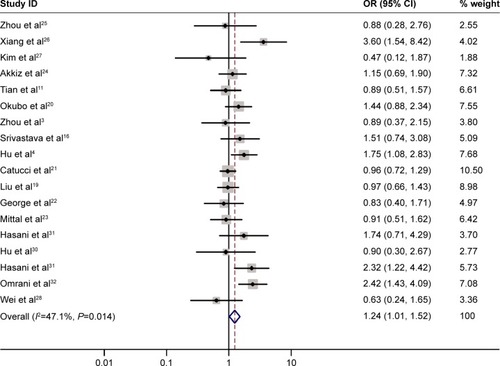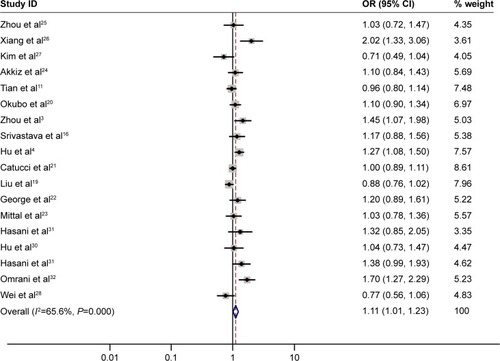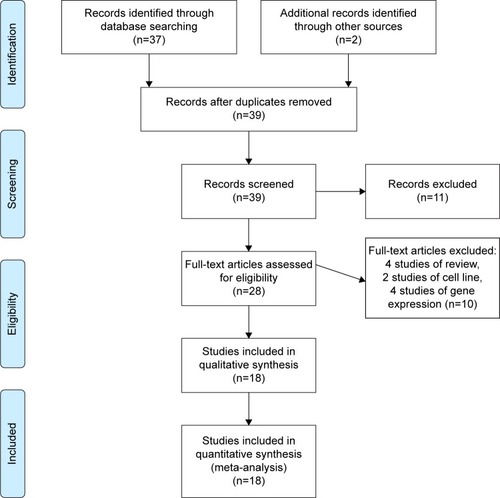Abstract
Background
MicroRNAs are a class of new noncoding RNA that play important roles in the pathogenesis of tumor. Rs3746444 in miR-499 is suggested to be associated with cancer susceptibility. In the present study, we assess the association between miR-499 rs3746444 polymorphism and cancer susceptibility through a meta-analysis.
Methods
We searched relevant articles from the PubMed and Embase databases. We screened all the resulting articles for adherence to the inclusion and exclusion criteria. The associations between miR-499 polymorphism and cancer susceptibility were estimated by computing the odds ratios (ORs) and 95% confidence intervals (CIs). All analyses were performed using Stata software.
Results
There are 18 datasets included in the analysis. Statistically significant associations were found between the miR-499 rs3746444 polymorphism and susceptibility to cancer (GG versus AA: OR =1.24, 95% CI: 1.01–1.52; G versus A: OR =1.11, 95% CI: 1.01–1.23). A subsequent analysis, on the basis of ethnicity for the population characteristic, showed that Asians had increased susceptibility to cancer (GG versus AA: OR =1.32, 95% CI: 1.09–1.59; GG + AG versus AA: OR = 1.17, 95% CI: 1.01–1.37). In the subgroup analysis of tumor type, none of the genetic models had statistically significant results. The meta-regression suggested that race and cancer types are not the source of heterogeneity in the present meta-analysis. No publication bias was detected by either the inverted funnel plot or Egger’s test.
Conclusion
Rs3746444 in miR-499 might be related to susceptibility to cancer.
Background
MicroRNAs (miRNAs) are a class of single-stranded noncoding RNAs typically composed of about 17–25 nucleotides that widely exist in human cells and play an important regulating role in many cellular processes, including proliferation, differentiation, and apoptosis, and also function as tumor suppressors and oncogenes.Citation1,Citation2 By specifically binding to the 3′-untranslated region of the target messenger (m)RNA, which leads to the degradation of the target mRNA or suppression of protein synthesis, miRNAs can regulate gene expression at the posttranscriptional level.Citation3 It was also found by several previous studies that many miRNAs are abnormally expressed in different kinds of cancer,Citation3–Citation4 and one study found that more than 50% of miRNA genes are located in cancer-related genomic regions or in fragile sites,Citation5 so miRNAs potentially exert significant effects on the development of human malignant tumors.
Single-nucleotide polymorphisms (SNPs), the most common type of mutations in the human genome, have become a focus in cancer research. One study has reported that miRNA regulates more than 30% of human genes;Citation6 even small changes in miRNA expression or function may have an enormous effect on the pathogenesis of numerous diseases. So SNPs in miRNA sequence may affect the miRNA biosynthesis and expression of coding genes and have an association with cancer susceptibility. There are some well-known SNPs in miRNA that affect the pathogenesis of human cancers, and the most widely studied have been miR-146a and miR-196a2 polymorphisms, including in primary research studies and meta-analyses.Citation7–Citation15 A study by Zhou et al found that rs3746444 A/G polymorphism in miRNA-499 increases the risk of cervical squamous cell carcinoma.Citation3 Tian et al reported that rs3746444 A/G polymorphism was not associated with lung cancer risk.Citation11 In a population-based case-control study by Srivastava et al which tried to elucidate the association between rs3746444 polymorphism and gallbladder cancer susceptibility, the researchers failed to find any significant results.Citation16 Although the miRNA-499 gene polymorphism and cancer relationship has been studied by many researchers, many conclusions drawn from the different studies on the same topic are inconsistent and have not reached consensus. This may be due to the restrictions of sample size and heterogeneity in cancer type and ethnicities.
Meta-analysis is a statistical technique for amalgamating, summarizing, and reviewing previous quantitative research. By using meta-analysis, a wide variety of questions can be investigated, as long as a reasonable body of primary research studies exists. In statistics, meta-analysis comprises statistical methods for contrasting and combining results from different studies in the hope of identifying patterns among study results, sources of disagreement among those results, or other interesting relationships that may come to light in the context of multiple studies.Citation17 Meta-analysis has been used to give helpful insight into the overall effectiveness of interventions, the relative impact of independent variables, and the strength of relationships between variables. The inconsistent published results of the association between miR-499 polymorphisms and cancer susceptibility may be attributed to the size of the samples, the ethnicity of the sample population, etc. In order to contribute to a better understanding of the role of this gene in the occurrence of cancer, we performed an updated meta-analysis on all available case-control studies, combining data together to reach a larger sample size, to get more statistical power to evaluate the relationship between miRNA-499 and cancer risk.
Materials and methods
Data sources
We retrieved articles from PubMed using the following terms: “miRNA or miR-499” and “cancer” and “polymorphism”. We evaluated potentially relevant publications by examining their titles and abstracts, and all studies matching the eligibility criteria were retrieved.
Study selection and data extraction
Qualifying studies were selected according to the following explicit inclusion requirements: 1) evaluation of the miR-499 rs3746444 polymorphism and cancer risks; 2) using the methodology of a case-control study or cohort study; and 3) sufficient published data for the computation of odds ratios (ORs) with 95% confidence intervals (CIs).
Duplicate and obviously unrelated articles were eliminated by a single reviewer (ZX). Abstracts of the remaining articles were examined independently by two reviewers (ZX and EZ) to determine whether the full-text article should be obtained. The following data were extracted from each included article: first author’s name, publication date, country of origin, ethnicity, cancer type, control characteristics, total number of cases and controls, and numbers of cases and controls with miR-499 rs3746444 genotypes.
Statistical methods
Hardy–Weinberg equilibrium (HWE) was firstly assessed for each included study among control groups using the chi-square test. We investigated the between-study heterogeneity by the Cochran’s Q test and quantified by I2 (a significance level of P<0.05 and/or I2≥50%). To obtain summary associations between miRNA polymorphism and cancer risk, we performed initial analyses with a fixed-effects model and then with a random-effects model if there was significant heterogeneity. The summary associations between miR-499 rs3746444 polymorphism and cancer risk were assessed by pooled ORs corresponding to 95% CIs. Pooled ORs were obtained by five genetic comparison models: heterozygote comparison (AG versus AA for rs3746444); homozygote comparison (GG versus AA for rs3746444); dominant model (GG + AG versus AA for rs3746444); recessive model (GG versus AG + AA for rs3746444); and allelic model (G versus A for rs3746444). The subgroup analysis according to ethnicity was investigated to estimate ethnic-specific ORs for Asians and Caucasians with five genetic comparison models. Meanwhile, stratified analyses by tumor type were also applied for each genetic comparison model.
The effect of publication bias was examined by inverted funnel plots and the Egger’s test. The significance of the intercept was determined by the Egger’s t-test as suggested by the Egger’s test. All P-values were two-sided, and all analyses were performed using Stata software version 11.0 (StataCorp LP, College Station, TX, USA).
Results
According to the inclusion and exclusion criteria, a total of 39 articles were eligible. Nine of them were meta-analyses and two were comments. Ten studies were excluded because of no cancer risk and missing data. Finally, 18 articles were included and used in quantitative synthesis for systematic review. There were 7,906 cases and 9,392 controls in the 18 datasets for miR-499 (rs3746444) SNP. A flowchart of the study selection process is shown in . The characteristics of the selected studies are summarized in . In the 18 studies, sample sizes ranged from 190 to 3,746. There were seven studies of Europeans and eleven studies of Asians. Almost all of the cases were histologically confirmed. Controls were mainly frequency matched by sex and age. The distribution of genotypes in the controls was mostly in HWE, except for four datasets of rs3746444. Studies with the controls not in HWE were subjected to a sensitivity analysis.
Table 1 Characteristics of all the studies in the meta-analysis
In the control group, the G allele of miR-499 polymorphism across different ethnicities ranged from 0.21 to 0.58. The average G allele frequencies among Asians and Caucasians were 17.8% and 24.5%, respectively.
Data in show that miR-499 rs3746444 polymorphism might be associated with cancer susceptibility in two genetic models. Compared with individuals carrying the AA genotype, individuals with the GG genotype were more likely to develop cancer, and significant results were also seen in the additive model (GG versus AA: OR =1.24, 95% CI: 1.01–1.52, P=0.014 for heterogeneity, I2=47.1%; G versus A: OR =1.11, 95% CI: 1.01–1.23, P=0.000 for heterogeneity, I2=65.6%) ( and ). Other genotypes had no statistically significant results (AG versus AA: OR =1.06, 95% CI: 0.94–1.21, P=0.000 for heterogeneity, I2=62.7%; GG + AG versus AA: OR =1.11, 95% CI: 0.99–1.24, P=0.000 for heterogeneity, I2=61.1%; GG versus AG + AA: OR =1.19, 95% CI: 0.97–1.48, P=0.002 for heterogeneity, I2=55.5%) ().
Figure 2 Meta-analysis of the association between miR-499 polymorphism and cancer risk under the homogeneity model (GG versus AA).
Abbreviations: CI, confidence interval; OR, odds ratio.

Figure 3 Meta-analysis of the association between miR-499 polymorphism and cancer risk under the allelic model (G versus A).
Abbreviations: CI, confidence interval; OR, odds ratio.

Table 2 Association between miR-499 (rs3746444) and cancer risk
Due to the heterogeneity in analysis, we characterized by ethnicity and cancer type for the stratified analysis (). In Asians, comparing with wild genotype (AA), homozygote genotype significantly increased the susceptibility to cancer (GG versus AA: OR =1.32, 95% CI: 1.09–1.59), and a significant result also could be found among those with the dominant model (GG + AG versus AA: OR =1.17; 95% CI: 1.01–1.37). For the Caucasians, there were not significant results for any model. In the stratified analysis by tumor type, the relationship between rs3746444 polymorphism and cancer susceptibility did not have statistical significance.
Table 3 Pooled ORs and 95% CIs for miR-499 polymorphism from stratified meta-analysis
When discussing source of heterogeneity, meta-regression demonstrated no statistical significance for race and cancer type (P>0.05). Therefore, these two factors were not the source of heterogeneity in the present meta-analysis.
Sensitivity analyses suggested that the present results were stable. Every single study involved in the meta-analysis was deleted each time to reflect the influence of the individual dataset on the pooled ORs. This procedure did not change the pooled ORs, supporting the robustness of our findings.
No publication bias was detected by either the inverted funnel plot or Egger’s test. The shapes of the funnel plot for the comparison of G-allelic and A-allelic rs3746444 SNP seemed approximately symmetrical. P-values of the Egger’s tests were not statistically significant (AG versus AA: t=0.76, P=0.456; GG versus AA: t=0.27, P=0.789; GG + AG versus AA: t=1.30, P=0.212: GG versus AG + AA: t=0.17, P=0.867; G versus A: t=1.43, P=0.169).
Discussion
SNP is the most common type of human genetic variation associated with cancer susceptibility and one of the important causes of population diversity. Much research effort has been directed toward understanding the role of SNPs located in precursor and mature miRNA and their influences on susceptibility to and progression of various diseases. Studies have pointed out that the SNP in miRNA precursor and mature miRNA may affect the process of gene coding and splicing of the miRNA sequence, thus affecting varieties of cancer susceptibility. These variations also make a contribution to cancer susceptibility through modulating the transcription of the primary transcript of miRNA processing and maturation and miRNA–miRNA interaction, so playing an important role in the carcinogenesis of various cancers.Citation4,Citation16,Citation18 Clarifying the association between miRNA SNP and cancer risk will help to further elucidate the mechanism underlying the carcinogenesis, in turn providing a new biomarker for screening high-risk populations for cancer and promoting the development of molecular-targeted therapy. Although there are many studies on the association between miR-499 polymorphism and cancer susceptibility, researchers cannot reach a definitive conclusion, possibly due to small sample size and differences in cancer type and ethnicity. So, in order to derive a more precise assessment of the relationship, we performed this meta-analysis.
It is known that incidence of gene polymorphism varies in different ethnicities. In our meta-analysis of association between miR-499 rs3746444 and cancer risk, we found that carriers of GG genotype have an increased risk for cancer compared with carriers of AA genotype in an Asian population, but not in a Caucasian population.
In the subgroup analysis of cancer type, we failed to find any statistically significant associations between rs3746444 and risk of several specific kinds of cancer, such as hepatocellular carcinoma, lung cancer, breast cancer, and gallbladder cancer. This may be due to the small sample size and limited number of studies on the types of cancer involved in our study, which could not provide a sufficient statistical power for detecting the associations. More studies on special kinds of malignant tumors should be considered to verify the relationship in the future.
There are several limitations existing in this study that should be considered. First, although the funnel plots and Egger’s tests did not show statistical significance, we only used English-language articles in the meta-analysis, so certain publication bias will exist. Second, the lack of original data in some valuable research restricted us to continue studying only some potential interactions, such as age, sex, family history, environmental exposure factors, and lifestyle. Third, this study lacks data from an African population.
Conclusion
We found that miR-499 rs3746444 GG genotype can increase the risk for cancer in an Asian population. However, the conclusion that rs3746444 in miR-499 is associated with cancer risk needs more study to be confirmed, and further consideration should be given to the influence of interactions between genes and exposure factors on cancer.
Acknowledgments
This research was supported by grants from the National Natural Science Foundation of People’s Republic of China (number 81372877); the National Young Scholars Science Foundation of China (number 81102058); the Foundation of Education Bureau of Liaoning Province (number 2009A755, number L2014317); the Public Welfare Fund Project for Science of Liaoning Province (number 2011002001); the Natural Science Foundation of Liaoning Province (number 2014021096); and the Excellent Talent Fund Project of Higher Education of Liaoning Province (LJQ2014087).
Disclosure
The authors report no conflicts of interest in this work.
References
- Esquela-KerscherASlackFJOncomirs – microRNAs with a role in cancerNat Rev Cancer20066425926916557279
- BartelDPMicroRNAs: genomics, biogenesis, mechanism, and functionCell2004116228129714744438
- ZhouBWangKWangYCommon genetic polymorphisms in pre-microRNAs and risk of cervical squamous cell carcinomaMol Carcinog201150749950521319225
- HuZLiangJWangZCommon genetic variants in pre-microRNAs were associated with increased risk of breast cancer in Chinese womenHum Mutat2009301798418634034
- ZhangBPanXCobbGPAndersonTAmicroRNAs as oncogenes and tumor suppressorsDev Biol2007302111216989803
- CarthewRWGene regulation by microRNAsCurr Opin Genet Dev200616220320816503132
- JazdzewskiKMurrayELFranssilaKJarzabBSchoenbergDRde la ChapelleACommon SNP in pre-miR-146a decreases mature miR expression and predisposes to papillary thyroid carcinomaProc Natl Acad Sci U S A2008105207269727418474871
- ShenJAmbrosoneCBDiCioccioRAOdunsiKLeleSBZhaoHA functional polymorphism in the miR-146a gene and age of familial breast/ovarian cancer diagnosisCarcinogenesis200829101963196618660546
- XuTZhuYWeiQKA functional polymorphism in the miR-146a gene is associated with the risk for hepatocellular carcinomaCarcinogenesis200829112126213118711148
- GuoHWangKXiongGA functional varient in microRNA-146a is associated with risk of esophageal squamous cell carcinoma in Chinese HanFam Cancer20109459960320680470
- TianTShuYChenJA functional genetic variant in microRNA-196a2 is associated with increased susceptibility of lung cancer in ChineseCancer Epidemiol Biomarkers Prev20091841183118719293314
- HoffmanAEZhengTYiCmicroRNA miR-196a-2 and breast cancer: a genetic and epigenetic association study and functional analysisCancer Res200969145970597719567675
- XuWXuJLiuSEffects of common polymorphisms rs11614913 in miR-196a2 and rs2910164 in miR-146a on cancer susceptibility: a meta-analysisPLoS One201165e2047121637771
- TianTXuYDaiJWuJShenHHuZFunctional polymorphisms in two pre-microRNAs and cancer risk: a meta-analysisInt J Mol Epidemiol Genet20101435836621532845
- WangZCaoYJiangCYangGWuJDingYLack of association of two common polymorphisms rs2910164 and rs11614913 with susceptibility to hepatocellular carcinoma: a meta-analysisPLoS One201276e4003922768213
- SrivastavaKSrivastavaAMittalBCommon genetic variants in pre-microRNAs and risk of gallbladder cancer in North Indian populationJ Hum Genet201055849549920520619
- GreenlandSO’RourkeKMeta-analysisRothmanKJGreenlandSLashTLModern Epidemiology3rd edLippincott Williams and Wilkins2008652653
- SluijterJPvan MilAvan VlietPMicroRNA-1 and -499 regulate differentiation and proliferation in human-derived cardiomyocyte progenitor cellsArterioscler Thromb Vasc Biol201030485986820081117
- LiuZLiGWeiSGenetic variants in selected pre-microRNA genes and the risk of squamous cell carcinoma of the head and neckCancer2010116204753476020549817
- OkuboMTaharaTShibataTAssociation between common genetic variants in pre-microRNAs and gastric cancer risk in Japanese populationHelicobacter201015652453121073609
- CatucciIYangRVerderioPEvaluation of SNPs in miR-146a, miR196a2 and miR-499 as low-penetrance alleles in German and Italian familial breast cancer casesHum Mutat2010311E1052E105719847796
- GeorgeGPGangwarRMandalRKSankhwarSNMittalRDGenetic variation in microRNA genes and prostate cancer risk in North Indian populationMol Biol Rep20113831609161520842445
- MittalRDGangwarRGeorgeGPMittalTKapoorRInvestigative role of pre-microRNAs in bladder cancer patients: a case-control study in North IndiaDNA Cell Biol201130640140621345130
- AkkizHBayramSBekarAAkgöllüEÜsküdarOGenetic variation in the microRNA-499 gene and hepatocellular carcinoma risk in a Turkish population: lack of any association in a case-control studyAsian Pac J Cancer Prev201112113107311222393998
- ZhouJLvRSongXAssociation between two genetic variants in miRNA and primary liver cancer risk in the Chinese populationDNA Cell Biol201231452453021861697
- XiangYFanSCaoJHuangSZhangLPAssociation of the microRNA-499 variants with susceptibility to hepatocellular carcinoma in a Chinese populationMol Biol Rep20123967019702322311030
- KimWHMinKTJeonYJAssociation study of microRNA polymorphisms with hepatocellular carcinoma in Korean populationGene20125041929722583825
- WeiJZhengLLiuSMiR-196a2 rs11614913 T > C polymorphism and risk of esophageal cancer in a Chinese populationHum Immunol20137491199120523792053
- VinciSGelminiSManciniIGenetic and epigenetic factors in regulation of microRNA in colorectal cancersMethods201359113814622989523
- HuXLiLShangMAssociation between microRNA genetic variants and susceptibility to colorectal cancer in Chinese populationTumour Biol20143532151215624136745
- HasaniSSHashemiMEskandari-NasabENaderiMOmraniMSheybani-NasabMA functional polymorphism in the miR-146a gene is associated with the risk of childhood acute lymphoblastic leukemia: a preliminary reportTumour Biol201435121922523888320
- OmraniMHashemiMEskandari-NasabEhsa-mir-499 rs3746444 gene polymorphism is associated with susceptibility to breast cancer in an Iranian populationBiomark Med20148225926724521023

